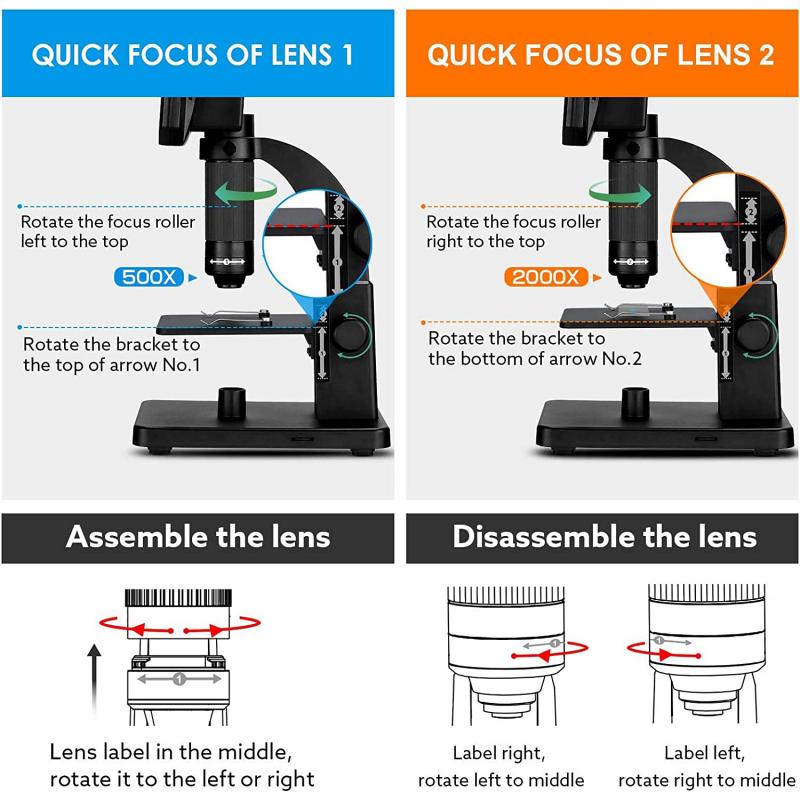How Does The Lens Of A Microscope Work ?
The lens of a microscope works by using the principles of refraction to magnify and focus the image of the specimen being observed. The lens is typically made of glass and has a curved shape, with one side being convex and the other side being concave. When light passes through the convex side of the lens, it bends or refracts, causing the light rays to converge towards a focal point. This convergence of light rays helps to magnify the image.
In a compound microscope, there are usually two lenses: the objective lens and the eyepiece lens. The objective lens is located close to the specimen and produces a magnified real image. This image is then further magnified by the eyepiece lens, which is positioned near the viewer's eye. The combination of these lenses allows for high magnification and resolution.
By adjusting the distance between the lenses and the specimen, as well as the focus of the lenses, the microscope can produce a clear and enlarged image of the specimen, enabling detailed observation and analysis.
1、 Refraction: Bending light to focus on the specimen.
The lens of a microscope works by utilizing the principle of refraction to bend light and focus it on the specimen. Refraction occurs when light passes through a medium with a different refractive index, causing the light to change direction. In the case of a microscope lens, the refractive index of the lens material is different from that of air, causing the light to bend as it passes through the lens.
The lens of a microscope is typically a convex lens, which is thicker in the middle and thinner at the edges. When light enters the lens, it slows down and bends towards the normal (an imaginary line perpendicular to the surface of the lens). As the light exits the lens, it speeds up and bends away from the normal. This bending of light allows the lens to converge the incoming rays onto a single point, known as the focal point.
By adjusting the distance between the lens and the specimen, the microscope can control the focus. Moving the lens closer to the specimen brings the focal point closer to the lens, allowing for magnification of the specimen. Conversely, moving the lens further away from the specimen increases the focal length, resulting in a smaller magnification.
In recent years, there have been advancements in microscope technology, such as the development of compound microscopes and electron microscopes. Compound microscopes use multiple lenses to further magnify the image, while electron microscopes use a beam of electrons instead of light to achieve even higher magnification. These advancements have allowed scientists to observe and study microscopic structures with incredible detail and precision.
In conclusion, the lens of a microscope works by utilizing the principle of refraction to bend light and focus it on the specimen. This fundamental concept, combined with advancements in microscope technology, has revolutionized our understanding of the microscopic world.

2、 Objective lens: Collecting and magnifying the light from the specimen.
The lens of a microscope is a crucial component that allows us to observe tiny objects with great detail. It works by utilizing the principles of optics to collect and magnify light from the specimen, enabling us to see it clearly.
The objective lens is one of the main lenses in a microscope. Its primary function is to gather light from the specimen and focus it onto the eyepiece or ocular lens. This lens is typically located close to the specimen and has a short focal length, which allows for high magnification. The objective lens is designed to have a small aperture, which increases the depth of field and improves the clarity of the image.
When light passes through the objective lens, it undergoes refraction, bending the light rays and converging them towards a focal point. This convergence of light rays allows for magnification of the specimen. The magnification power of the objective lens is determined by its focal length and the distance between the lens and the specimen.
In recent years, advancements in lens technology have led to the development of high-quality objective lenses with improved resolution and clarity. These lenses are often made using specialized materials and coatings to minimize aberrations and enhance image quality. Additionally, some microscopes now incorporate advanced techniques such as phase contrast or fluorescence microscopy, which further enhance the visualization of specimens.
In conclusion, the lens of a microscope, particularly the objective lens, plays a crucial role in collecting and magnifying light from the specimen. Through the principles of optics and advancements in lens technology, we are able to observe and study microscopic objects with remarkable detail and clarity.

3、 Eyepiece lens: Further magnifying the image for the observer.
The lens of a microscope is a crucial component that allows us to observe objects at a much higher magnification than what is possible with the naked eye. It works by utilizing the principles of optics to bend and focus light, enabling us to see tiny details that would otherwise be invisible.
The lens system of a microscope consists of two main parts: the objective lens and the eyepiece lens. The objective lens is located near the specimen and is responsible for gathering light and forming a magnified image. It has a short focal length, which means it can capture a wide field of view and produce a highly magnified image.
Once the objective lens has formed the magnified image, it projects it into the eyepiece lens. The eyepiece lens further magnifies the image for the observer. It has a longer focal length compared to the objective lens, allowing for additional magnification without sacrificing clarity.
The eyepiece lens works by bending the light rays that pass through it, converging them to a focal point. This focal point is where the observer's eye should be positioned to view the magnified image. By placing the eye at the focal point, the observer can see the image with enhanced magnification.
It is important to note that the lens of a microscope has evolved over time. With advancements in technology, modern microscopes now often incorporate compound lenses, which are made up of multiple lens elements. These compound lenses help correct for various optical aberrations, resulting in improved image quality and clarity.
In conclusion, the lens of a microscope plays a vital role in magnifying the image of the specimen. The objective lens gathers and forms the initial magnified image, while the eyepiece lens further magnifies it for the observer. Through the principles of optics, the lens system allows us to explore the microscopic world with incredible detail and precision.

4、 Numerical aperture: Controlling the amount of light collected.
The lens of a microscope plays a crucial role in magnifying and resolving tiny objects that are otherwise invisible to the naked eye. It works by utilizing the principles of optics to focus light and create a magnified image.
The lens of a microscope is typically a compound lens system, consisting of multiple lenses that work together to achieve high magnification and resolution. When light passes through the lens, it undergoes refraction, which causes the light rays to bend and converge. This convergence allows the lens to focus the light onto the specimen being observed.
One important factor in the functioning of the lens is the numerical aperture (NA). Numerical aperture is a measure of the lens's ability to gather and focus light. It is determined by the refractive index of the medium between the lens and the specimen, as well as the angle at which the light enters the lens. A higher numerical aperture allows for greater resolution and a larger cone of light to be collected, resulting in a brighter and more detailed image.
Controlling the amount of light collected is another crucial aspect of the lens's function. Microscopes often have adjustable diaphragms or iris mechanisms that can be used to control the amount of light entering the lens. This is important because too much or too little light can affect the quality of the image. By adjusting the diaphragm, the user can optimize the amount of light collected, ensuring a clear and well-illuminated image.
In recent years, advancements in lens technology have led to the development of high-resolution lenses with improved optical performance. These lenses utilize advanced materials and coatings to minimize aberrations and maximize light transmission, resulting in sharper and more detailed images. Additionally, the use of digital imaging techniques and software has allowed for further enhancement and analysis of microscope images.
In conclusion, the lens of a microscope works by utilizing the principles of optics to focus light and create a magnified image. The numerical aperture controls the amount of light collected, while advancements in lens technology continue to improve the resolution and quality of microscope images.









































